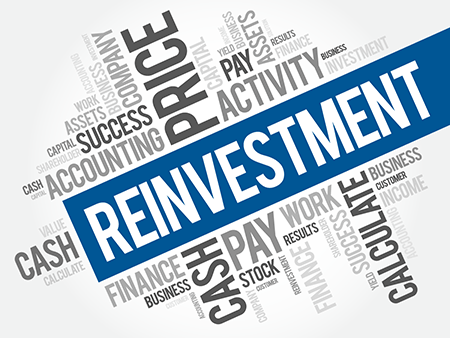A Practical Guide to Dividend Reinvestment Plans

By Dale Gillham
A dividend reinvestment plan (also known as DRP or DRIP) is a simple and cost effective way to increase the value of your portfolio. Companies that offer a DRP provide investors with the option to automatically reinvest their cash dividends by purchasing additional shares. This allows investors to accumulate more shares from their existing investments without using any of their capital.
Before investing in a DRP, it's important to understand how it works and to consider the advantages and disadvantages of this strategy. What I share may surprise you, especially when it comes to the drawbacks of dollar cost averaging.
Reinvestment of dividends: How does it work?

When a company declares a dividend and the investor chooses to participate in a dividend reinvestment plan, the cash is automatically reinvested in additional shares based on the proportion of dividends they would have received in cash. To calculate the approximate number of additional shares you will receive in your portfolio, you take the amount of the cash dividend and divide it by the current share price of the company, rounded down to the nearest whole share.
Shares in a DRP are usually issued at current market prices although sometimes they are offered at a discount to encourage shareholders to take up the program so the company issuing the dividend can retain the capital in the business. Most companies allow you to nominate whether all or part of your cash dividend is reinvested into the DRP.
Many ASX listed companies offer dividend reinvestment plans including exchange traded ETFs and listed managed funds. You can check with your stock broker which companies offer this program. Now, let's look at an example of how DRPs work.
DRP worked example
Darryl owns 1,500 shares in XYZ Ltd and the shares are currently trading at $15 each. In October 2022, the company declares a dividend of $0.20 cents per share. Darryl could either take the $300 (1,500 × 0.20) as income or receive 20 additional shares in the company (300/$15). Darryl decides to participate in the DRP and receives 20 additional shares in December 2022.
Once you receive payment, the company will issue a dividend statement detailing the allotment of shares you received as part of the DRP. You need to file this statement with your contract notes so that you have all of your records available when preparing your tax return.
Investors who opt into the DRP are eligible to receive franking credits on the income that is reinvested through the DRP.
Bonus share plan
Some companies, such as QBE and ANZ, also offer what is called a bonus share plan (BSP), which is also referred to as a bonus option plan. This enables shareholders to receive bonus shares instead of cash dividends to increase their shareholdings. Like the DRP, investors can nominate whether some or all of their cash dividend is reinvested in the BSP.
Shares are issued at current market prices and don't incur any brokerage or commission. Generally, shares issued under a BSP are not treated as dividends for the purposes of Australian income tax or dividend withholding tax. Although, circumstances will vary depending on the investors’ circumstances; therefore, it is recommended you check with your accountant before deciding to invest in a bonus share plan.
Is a DRP a good idea?

Now that you understand how DRPs work, what are the benefits of using this investment strategy?
1. Compounds returns
The major benefit of a DRIP is the ability to compound your returns by reinvesting your earnings, resulting in a greater amount of money working for you. This is important because the power of compounding allows you to increase the number of shares received with each DRP, assuming the dividend payout remains the same.
2. Cost savings
A DRP also helps to decrease trading costs, such as brokerage fees, as it eliminates the need to place individual orders for each payment received. This makes it an ideal option for investors wanting to save costs as they establish their portfolio.
3. Easy to opt in
Another advantage of DRPs is that they are easy to set up and manage, and many brokers offer them as an option. In addition to simplifying how you manage your portfolio, it also offers the flexibility to switch between DRP and cash dividend payments as needed.
4. Forced savings
A DRP is an effective form of forced savings, as long as you know how to protect your capital in case the stock declines. That's why I strongly recommend you always apply a stop loss on every stock you own to ensure you don't take on heavy losses.
5. Tax advantages
DRPs also offer you the advantage of tax incentives such as franking credits. As the company is paying a portion of their profits to shareholders in the form of dividends, it will also include franking credits that can be used to offset any tax liability. Depending on your tax rate, you may receive a refund on the tax already paid by the company.
6. Supports your investment goals
Reinvesting dividends is a logical choice for investors managing a growth portfolio as it helps to compound returns. For investors with an income-focused portfolio, receiving dividends as a cash payment may be more preferable. This is common among retirees who prioritise extra income to support their lifestyle rather than capital growth.
7. Passive investment approach
DRPs can be a beneficial strategy for passive investing, as it enables you to gradually grow your investment portfolio. After setting up a DRP, dividends will be automatically reinvested into additional shares by the company on your behalf. This provides convenience for investors who are unable to actively manage their investments but still desire the benefits that the stock market offers.
What are the disadvantages of a dividend reinvestment plan?
Like any product or strategy, there are also potential disadvantages to consider.
1. More time to administer your investments

DRPs can also add complexity to your portfolio, as they require more record keeping. As each parcel is purchased on a different date and at a different price, you will need to keep track of the cost base for each parcel in order to accurately calculate the capital gains or losses when you sell. This will increase the time required to administer your portfolio.
2. Higher fees to manage your portfolio
The cost of accounting and taxation fees may increase significantly as each individual parcel will need to be reported on. Given this, it's important to maintain accurate records. I recommend you get into the habit of filing your dividend statements when you receive them with the original contract note when you purchased the shares. That way, you'll save time when it comes to handing over your records to your accountant.
3. Less control over the timing of reinvesting
Another disadvantage is that you have less control over when you are notified of the dividend and when it's reinvested. This means that the share price could move significantly between the record date (when you are entitled to the dividend) and when it's reinvested, which can lead to losses in your portfolio.
4. Limited diversification
A DRP may limit the diversification of your portfolio as reinvested dividends are only allowed in the stock of the issuing company. The downside of this is if the stock holding increases substantially compared to the other stocks in your portfolio, it can have a negative impact on the overall performance of your portfolio, as well as increase your investment risk if the stock price declines.
5. Dollar cost averaging
Dollar cost averaging is the process of buying a fixed amount of stock at regular intervals, regardless of the price, to reduce volatility and take advantage of price fluctuations. While this strategy has its advantages in a rising market, it is not a good strategy to adopt when the market is falling, which is why I believe this is when you need to stop reinvesting in dividends. Let me explain why.
As shown in the table below, let’s say you invest $200 every three months into a unitised fund that initially had a unit price of $20. Over fifteen months, the market rises and then falls (causing the unit price to drop to its original value). In this instance, while we invested $1,000 over fifteen months, we are now at a loss because we only have 43.32 units at $20, which equates to $866.60. Imagine if you invested in a fund that continued to trend down for years. I don’t need to say anymore!
In my opinion, this strategy is flawed because not only has the investor lost the opportunity to invest their money in assets that are rising in value, but they are taking higher risks investing in assets that are potentially falling in value with no guarantee of making a profit, which is ludicrous.
| Example of Dollar Cost Averaging | |||
| Month | Contribution | Unit Price | Units Purchased |
| 3 | $200 | $20 | 10 |
| 6 | $200 | $24 | 8.33 |
| 9 | $200 | $30 | 6.66 |
| 12 | $200 | $24 | 8.33 |
| 15 | $200 | $20 | 10 |
| Total | $1,000 | 43.32 | |
6. Fewer investment options
By reinvesting dividends, investors are restricted to purchasing more shares of the same stock, which limits their ability to take advantage of other investment opportunities. This prevents you from taking advantage of changing market conditions and investing in stocks with the potential for higher returns.
Before I finish up, let's consider what you could do with your cash if you prefer not to reinvest your dividends.
What if you choose not to reinvest dividends?

If you prefer to receive your dividend payments in cash, rather than reinvesting them – the question is what should you do with the cash? I strongly recommend you use it to fund other investments.
For example, you could take the money and place it in an interest-bearing account to build up a deposit for a home or use it to pay off debt. You could also use it to pay down your home loan much quicker. Alternatively, you may want to use it to purchase other stocks to build up your portfolio. Either way, the important point to remember, as I outline in my article on the laws to wealth creation, whatever you earn from your investments must be reinvested into other assets, so you continue to compound your returns.
There you have it. Dividend reinvestment plans provide a great way for investors to build up their portfolio while taking advantage of tax incentives and cost savings. Remember, it's also important to stay on top of your investments and know how to protect your capital if your stocks start to fall away.
If you want to learn how you can maximise your returns in the stock market, purchase my award-winning book 'Accelerate Your Wealth: It's Your Money, Your Choice'. It is packed with simple, yet powerful DIY investment strategies.
Others who read this also enjoyed reading:






